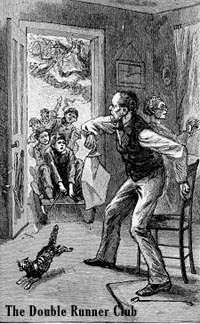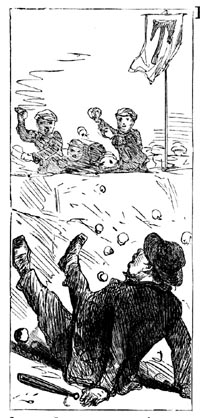|
FRESH STUFF DAILY |
|
|
||
|
|
||
|
|
||
|
SEE ALL SIGNED BOOKS by J. Dennis Robinson click here |
||
Page 2 of 3
Aldrich’s novel, reprinted in scores of editions, is still in print today. That is not true of another Portsmouth winter boy battle. The adventures of The Double Runner Club by Benjamin Penhallow Shillaber (1814-1892) are now largely forgotten. Born in Portsmouth, Shillaber went on to become one of the best known American humorists of the nineteenth century. In 1848, two decades before Aldrich published his classic adventure book for boys, Shillaber invented Ike Partington, whose major function, initially, was to plague his aunt, Mrs. Ruth Partington, a comic character reportedly based on the author’s own aunt from Portsmouth. Shillaber left the Seacoast at age 18 to become a journalist and publisher in Boston, but always felt a deep connection to Portsmouth.
The Double Runner Club, last in the Ike Partington series, opens with a death-defying race down Mason’s Hill, the steepest slope in Rivertown, Shillaber’s fictional name for Portsmouth. (Aldrich typically refers to the city as "Rivermouth"). This time, it is the Corner Boys who are dead set against the Downtowners, but the historic rivalry is the same. But when a tough kid named Si Fairbanks arrives from Boston with a top-notch sled nicknamed "The Flyer", he easily defeats the local boys. The only way to out race the big-city kid, Ike and his friends decide, is to build a double-runner sled. Raising a dollar, they convince Mr. Dennett, the carpenter, and Mr. Fernald, the blacksmith, to build the machine. Carrying six boys, the double-runner handily defeats Si and the Flyer, but hurtles toward the waters of the mill pond. Later Ike and his cronies accept a challenge from the boys of nearby Tatnic. They win again, but lose control of the massive double-runner and plow through the door of a local farm house, tearing up the threshold and the kitchen floor.
Shillaber, who earns a footnote in American literature as one of the nation’s earliest comic writers, never matched the fluid and exciting writing style of Aldrich’s Story of a Bad Boy. Critics note that Shillaber’s juvenile fiction often falls into the trap of describing events, rather than dramatizing them. But Shillaber biographer John Q. Reed suggests that BP deserves extra credit for promoting the renaissance in children’s adventure literature in the nineteenth century. His early contribution to the rise of "boy books" paved the way for Mark Twain’s adventures of Tom Sawyer and Huckleberry Finn. Twain acknowledged his debt to both Portsmouth authors. Before BP Shillaber, American books for children were highly didactic and moralistic, populated by dull, squeaky-clean characters that exemplified perfect little boys and girls. The Peter Parley and Little Rollo series of the early 1800s taught children to be thrifty, polite, obedient, industrious, careful and well groomed. Shillaber despised these so-called "Sunday School" books and satirized them in his newspaper writing. Good parents, he chided, should whip their children regularly. Shilliber’s hero Ike Partington, who first appeared in print when Thomas Bailey Aldrich himself was only a boy, was a rebel with a distinct cause. By designing Ike as both devilish and unapologetic, Shillaber paved the way for adventure books that children could identify with and read with enthusiasm. In fact, Shillaber developed his own theory of adolescent behavior that plays well even today. Ike Partington, Shillaber once wrote, was designed specifically as "an imitation of the universal human boy". Real boys, the author argued, naturally do bad things and should be allowed to experiment and work out their mischievous nature, rather than be molded too early into well-mannered adults. In the introduction to Lively Boys! Lively Boys!, first in the Ike Partington series, Shillaber expounds: "The Boy must not be judged by the standard of Childhood or Manhood. He has a sphere of his own; and all of his mischief, frolic, and general deucedness, belongs to his own condition. The Boy has but little plan, purpose, or intention, in what he does, beyond having a good time. Boys that think, and have no interest in the doings of boyhood, may be delightful aids to a quiet home; but the life, spirit, energy, and health of the active Boy, comes with his activity." The corollary of the "human boy" axiom, Shillaber implies, is that the adult male is no more responsible for his actions as a boy, than the butterfly is for the destructiveness of the caterpillar it once was. Boyhood, in essence, is a free pass with no strings attached. There are no juvenile delinquents in Shillaber’s world, just more boys. Continue BLOOD ON THE SNOW Please visit these SeacoastNH.com ad partners.
News about Portsmouth from Fosters.com |
| Wednesday, May 01, 2024 |


|
Copyright ® 1996-2020 SeacoastNH.com. All rights reserved. Privacy Statement
Site maintained by ad-cetera graphics

 HISTORY
HISTORY



 Over the next thirty years, Shillaber slowly developed the mischievous Ike in his newspaper columns that were collected into books. But Shillaber was in his sixties, nostalgic for his youthful days in Portsmouth, before he finally fleshed out young Ike Partington. His three adventure novels for boys, published between 1878 and 1882, are filled with intriguing memories of life along the Seacoast in the early 1800s.
Over the next thirty years, Shillaber slowly developed the mischievous Ike in his newspaper columns that were collected into books. But Shillaber was in his sixties, nostalgic for his youthful days in Portsmouth, before he finally fleshed out young Ike Partington. His three adventure novels for boys, published between 1878 and 1882, are filled with intriguing memories of life along the Seacoast in the early 1800s. Tom Bailey and Ike Partington are bad little boys. Tom, Aldrich’s alter ego, manages to shoot an arrow into a friend’s mouth while playing William Tell. He sets a wooden carriage on fire in the middle of Market Square and knocks himself unconscious with a stash of stolen gunpowder. Ike frequently lies, occasionally steals, disrupts school and cruelly dispatches a cat.
Tom Bailey and Ike Partington are bad little boys. Tom, Aldrich’s alter ego, manages to shoot an arrow into a friend’s mouth while playing William Tell. He sets a wooden carriage on fire in the middle of Market Square and knocks himself unconscious with a stash of stolen gunpowder. Ike frequently lies, occasionally steals, disrupts school and cruelly dispatches a cat.














